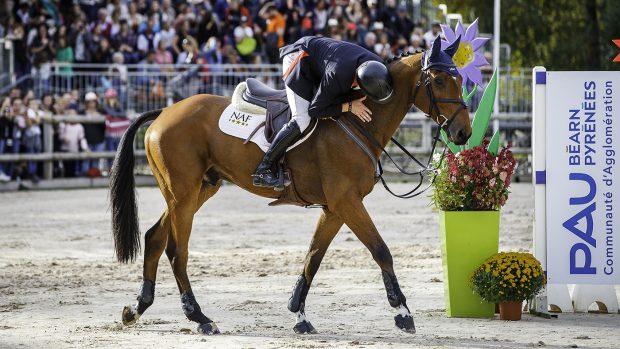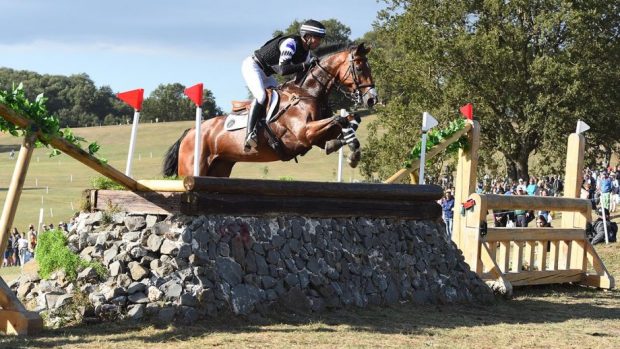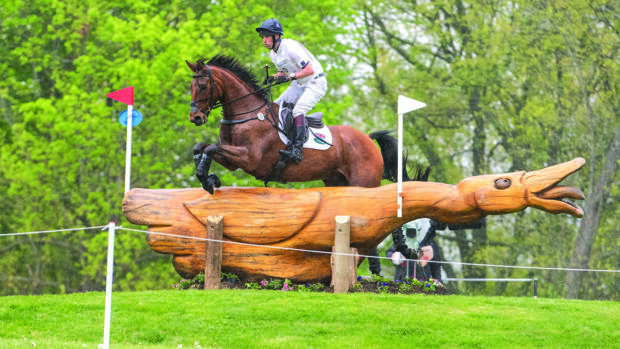Tim and Jonelle Price are some of the very best in the business when it comes to cross-country riding.
On a webinar organised by the Lucinda Green XC Academy, they shared some of their secrets…
1. Balance is key and having the horse channelled on the aids
“The ability to ride a horse in good balance, between two legs and two reins at any given moment, is imperative,” says Jonelle. “Then you can get more complicated with the ability to access more gears within the paces.
“To make your cross-country riding smoother, you have to make a smaller change over more strides to maintain that rhythm, to be efficient.”
2. Don’t overtrain
Jonelle went on to say that much of that comes down to “day to day flatwork” and that the Prices don’t believe in overtraining cross-country.
“You see a lot of arena eventing in Britain, it’s definitely got merits but it’s not a huge part of our system,” she says.
“While we don’t look for a particular breed, a horse has to be an athlete when we go to look at it. It has to have a leg at each corner, natural balance. Perhaps that helps our slightly minimalistic approach to cross-country training.”
3. Make it fun, use terrain and control the direction
The Prices use a field that has various “bits and pieces” of cross-country obstacles in it and a large part of going there is about a horse starting to realise it’s fun.
“They’re an animal that loves to run and jump – we go down there and try to make it fun for them,” says Tim Price. “It’s about finding different questions that are terrain-related – up and down banks, ditches. They think they’re the biggest, scariest thing in the world, then after a few minutes they realise they can skip over.
“It’s also important they feel comfortable on changeable surfaces so we do a lot of that playing around in different places.”
Tim emphasises that in those sessions, the horse has to go where he asks.
“They can’t scoot up the hill there towards home or because a horse has called that way, so it’s just playing around with that control element,” he says.
4. Early problems at events don’t matter
“We’re not out to win a BE100 or a novice, we’re taking young horses out to learn on the job and if they have a wobble, we can live with that,” says Jonelle.
Tim adds: “It’s only at novice you get things that are a bit skinnier, or a fence on a related distance off a bank to something requiring accuracy. I’ll often have a problem at a combination, then go and do my homework – I’ll explain to the owners it’s no problem, that I’ll go home and educate them. Sometimes a horse will even go up to advanced before they have a significant issue.
“There are various ways to deal with that – repetition with wings on fences until they understand or sometimes you need to create the problem at home and show them the way so they understand. It goes back to what Jonelle said about having the horse between both reins and both legs. If a horse is going to deviate from that, you need to understand the whys and hows.”
5. You don’t have to use speed in training
“I quite enjoy just walking and trotting over a few banks and ditches,” says Jonelle. “The horses know they must stay in front of my leg and go, not just because I’m using speed to get to the other side. With young horses, I think nothing of walking up some banks and letting them stumble up and down or into a wee ditch, so they get aware of where their legs are. If you use speed, they’re not quite aware of what they’ve done.”
6. Horses must dig deep in fitness work
“For 80% of our training we’re on a straight line grass gallop,” says Tim. “We have a good warm-up to get there, perhaps 25 minutes trotting, and when we get to the gallop we let them run – it’s not a nice round hand canter. We know where they start to flag and then they have to dig deep to go up the last bit. We believe that preparation has been fundamental in our horses’ health.”
7. You don’t have to start out fast in cross-country riding
At every level, Tim employs a strategy of increasing speed through the course.
“I start in a fairly quiet rhythm, then build up through the middle, then push them home a bit quicker,” he says. “As you go up the grades you can repeat the same thing, but obviously a bit quicker.
Jonelle adds: “The key thing is rhythm – going fast is not about who can gallop the fastest, it’s about the person who can start and finish the course in the most efficient way, with the least disruptive effect on the horse. When Tim refers to picking up speed, he’s always within a rhythm.
“I’d encourage grassroots people to practise picking up a fence out of a rhythm, even if only at 350mpm to start with, then when you can consistently pick that rhythm up you can up the speed to 375 or 400mpm, but the emphasis should be on rhythm not speed itself.
“You see far too many young or inexperienced riders land and tear away from fences and then 100m out from the next fence, they’ve got a wrestle going on, trying to get horse back under control to put it in the right balance to jump the jump.”
8. Don’t obsess about seeing a stride
“I’ve naturally got a good eye, but earlier in my career there was many a time I’d miss at a competition or in training, and I became frustrated about it, spent too much time going into it,” admits Tim. “Then as things progress, all the other important facets of going cross-country come into play and the emphasis on the perfect distance came away, which in turn gave better distances.
“For me now, a distance is more of an observation than a real consideration. It’s something that’s coming up – that was a bit close, that one a bit further way – but the horse picks up. If it’s a real technical fence, yes, you have to set up and make sure of a few more things, but overall round the course, it’s an observation of a fence, you’ve got the balance, the rhythm.”
Jonelle says she doesn’t put herself under huge pressure to see a big galloping distance in the first few minutes.
“I find it easier to ride to time over 10 to 12 minutes over long format courses than six minutes over short format classes,” she says. “If I’m five seconds down at the first minute, I don’t panic. In the middle I’m trying to be efficient, trying not to lose time, then in the last stages I try to bring it home. I accept I might have one or two waiting distances in the early part, so I’m aware of it but not freaking out about it.”
“The stride comes up much easier if you’re in the correct rhythm. People come for a lesson and are so desperate to see a stride it becomes a negative and distracts. If we can shift focus to the rhythm, that becomes their friend.”
9. Tick the boxes
Jonelle and Tim said they are both quite natural riders who don’t suffer hugely from nerves. However, Jonelle did share one tool she’s found useful for cross-country riding.
“I turn cross-country into a box-ticking exercise – as I go round I’m ticking off boxes, so I might think, ‘That box was a bit challenging’, then I go to the next one. It simplifies my purpose and takes some complication out of it.”
You might also be interested in:

How often does Tom McEwen go cross-country schooling? Do his horses wear studs for it? Find out here…

Top eventing stars to move to new yard in 2023: ‘It’s exciting but daunting’

8 top tips to help you look like a pro over a jump

Subscribe to Horse & Hound magazine today – and enjoy unlimited website access all year round
Horse & Hound magazine, out every Thursday, is packed with all the latest news and reports, as well as interviews, specials, nostalgia, vet and training advice. Find how you can enjoy the magazine delivered to your door every week, plus options to upgrade your subscription to access our online service that brings you breaking news and reports as well as other benefits.




